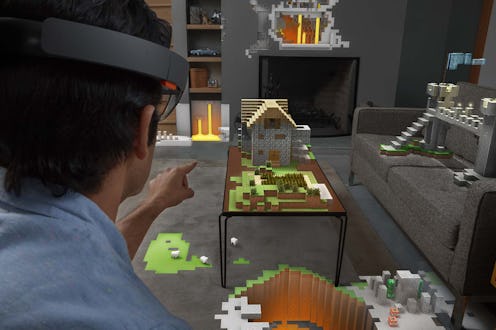News
Microsoft's HoloLens Is Making Tech Come Alive

While you were busy ignoring Microsoft in favor of some other OS, the technology company was unveiling a surprisingly sensible Windows 10 and, larger than that, the future of technology as a whole: the HoloLens. Billed as the first and only untethered holographic computer, this augmented reality device acts like an elevated Oculus Rift. Whereas Oculus Rift is simply virtual reality and nothing more, the HoloLens brings your world to its tech. Simply strap on the wraparound glass lenses, and the world around you is populated by interactive holographs. Holographs are only seen by the wearer but look just as real as the coffee table in your front room that you just happen to be playing Minecraft on, a particular highlight of the HoloLens demo.
The official HoloLens announcement came at a Windows 10 event held earlier Wednesday at Microsoft Headquarters in Redmond, Washington. Publications like the Verge and Wired published pieces detailing their dazzling experiences with the device, though it was Take-Two Interactive CEO and Chairman Strauss Zelnick who first made mention of it way back in November. Tech heavy-hitters knew this next phase in wearable computers was coming, and so did heavy-hitters outside of the computer-centric community.
Every first impression of the HoloLens hit a crescendo when the device took its wearer to Mars. Microsoft and NASA have actually collaborated on this endeavor, and not just so techies and space enthusiasts can virtually rub elbows with the Curiosity rover. If all goes according to plan, the 2020 mission to Mars will include the OnSight platform seen on the HoloLens. Using the platform developed by NASA's Jet Propulsion Laboratory in Pasadena — the same lab that guided Curiosity to the big red planet — NASA will be able to see what Curiosity sees as well as monitor crucial information being transmitted about the surface of Mars.
Though the HoloLens requires no computer or additional technology to work, it does enhance the technology around you. One of the ways to use the device, aside from voice commands and simply looking in a certain direction, is through a good old-fashioned computer mouse. Yet another way to interact with the HoloLens is by pointing, or as Microsoft calls it: AirTapping. Using a combination of AirTapping and an actual computer and its mouse, an example video shows the many creative uses of the HoloLens, transforming standard 2D CADs into tangible components that might very well change the way we design. Imagine turning a pen and paper concept into something physical in mere minutes.
HoloLens can also perform tasks as basic as checking the weather via interactive holographic widgets overlaid on normal objects. Skype calls become all the more mobile when you're able to literally go anywhere and conduct a video chat. In terms of gaming, perhaps the most enjoyable task in Microsoft's demonstration was a pseudo-Minecraft game that was as multi-layered as the world around it. Users were able to interact with building blocks and craft a fake world in their own world, going so far as to destroy the holographic blocks and then have even more building blocks revealed.
Though HoloLens has no peripheral vision capabilities, it's certainly come the closest to bridging the gap between the digital and the physical world. HoloLens is expected to be released around the same time as Windows 10, though neither a hard date nor an estimated cost has been released yet.
Image: Microsoft